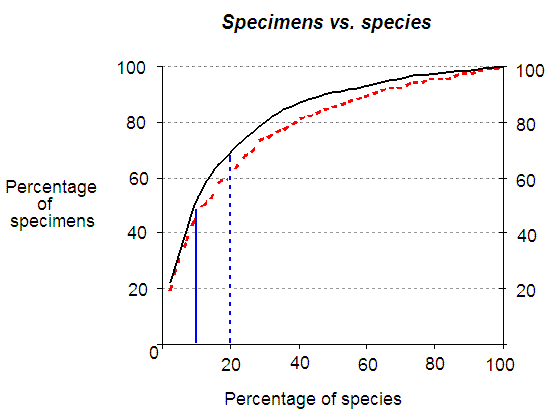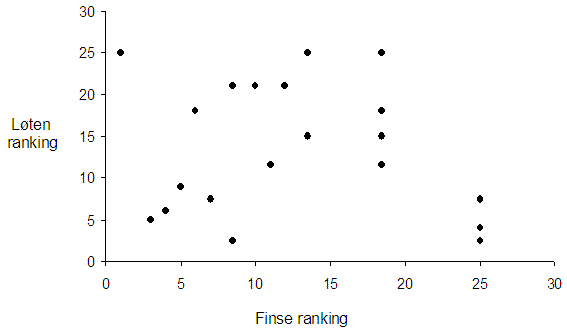Case StudiesWooden fencesWooden fences were once common in Scandinavia since both labour and raw materials were abundant and cheap. Such fences, now rarer, were made of hard, thin boards, typically of spruce or pine and an important characteristic of such fences is that the thin boards would dry out quite quickly once the rain stopped. The fluctuating water levels, the exposure to cold in winter and considerable drying out in summer combined to make such a thin-board fence a challenging place for mycelial colonization. Moreover, the thin boards provided a rather small volume of wood for fungal attack. All in all such fences presented a distinct ecological niche for wood-rotting fungi so the authors of the paper listed below thought it worthwhile to analyse the fence-inhabiting fungi while there were still fences around for analysis. Their investigation was confined to the wood-inhabiting corticioid and polypore fungi. The great majority of the species found were corticioid fungi, which have flattish, sheet-like fruiting bodies. The study sites were at Løten and Finse in Norway. Løten is in the south-western lowlands, 250 metres above sea level, with coniferous forests as the dominant vegetation type. Finse is in the south-central alps, at an altitude of 1220 metres with alpine meadows the dominant vegetation type. Løten is typically continental (dry, cold winters and dry, warm summers; average annual rainfall is 535 millimetres) while Finse has a humid, cold and oceanic climate with an average annual rainfall of 1050 millimetres. The average January temperature at both sites is -10 degrees Celsius but the average July temperatures are 7 degrees (Finse) and 14 degrees (Løten). Over the 1981-1982 period over 300 specimens were collected from each site but far fewer species were found at Finsen (42) than at Løten (82), with 27 species common to the two sites. Corticioid fungi were far more common than the polypores. Four polypore specimens (representing three species) were collected at Finse, while 25 polypores (from 10 species) were found at Løten. Presumably the polypores are generally poor colonizers of thin, exposed wood. Given their very rare appearances they will feature no more on this web page so that all the species mentioned from now on will be corticioid fungi. Hyphodontia subalutacea was the most common species at Finse, accounting for 73 of the 325 specimens collected there. Then followed Amyloathelia crassiuscula (30), Botryobasidium obtusisporum (30), Botryobasidium subcoronatum (29) and Jaapia argillacea (19). At Løten the top five were Amyloathelia crassiuscula (39 of 377 collections), Phlebia cretacea (31), Xenasmatella filicina (26), Hypochniciellum molle (15) and Hyphodontia breviseta (15). What if you start looking at numbers of specimens and species in percentage terms? At Finse there were 42 species, so a single species equates to 2.3% of the total number of species. Of the 325 specimens collected there, 73 equates to about 22% of the total specimens. Put this way you could say that the most abundant 2.3% of species accounted for 22% of the specimens. At Løten, with 82 species in total, 2 species equate to 2.4% of the 82. Now, look at the two most abundant species at Løten, which were listed in the previous paragraph. Together those 2.4% of species accounted for 70 collections, or about 19% of all the specimens collected at Løten. In percentage terms the results for the two sites are very similar. Continuing this exercise for all the species and specimens at each site gives the following graphs. The sold black line gives the information for Finse and the broken red line for Løten. Here are two more specific examples to help you understand the graphs. Look at the sold, vertical blue line which is positioned at the 10% point on the horizontal axis. You can see that the most abundant 10% of species at Finse accounted for about 50% of the specimens collected there and the most abundant 10% of species at Løten accounted for about 45% of the specimens there. If you look at the broken, vertical blue line you can see that the most abundant 20% of species at Finse accounted for about 70% of the specimens and that the corresponding figure for Løten is about 60%. At Løten there were relatively more species with just a few specimens per species than there were at Finse, so the Løten line approaches the final 100% mark more slowly than does the Finse line. In the natural world it is often the case that a small proportion of species accounts for a disproportionately large proportion of sightings or occurrences. For example, each year about 40 bird species appear in my garden, resulting in several thousand individual visits. Probably fewer than 10 of those species would account for about 80% of all bird visits. Of the species common to both sites Amyloathelia crassiuscula is unusual in that there were roughly equal numbers and percentages of specimens of this species from both sites, 39 from Løten (a little over 10% of all specimens) and 30 from Finse (a little over 9% of specimens). Generally the rankings of the common species were markedly different at the two sites. For example, while Hyphodontia subalutacea was the most abundant species at Finse it was found only once at Løten and Botryobasidium obtusisporum, the second ranking species at Finse was not found at Løten. Similarly no collections of either Phlebia cretacea or Xenasmatella filicina were found at Finse, but those species were the 2nd and 3rd most abundant species at Løten. The following scatter plot shows the Finse and Løten rankings for each of the 27 species common to the two sites. The horizontal axis shows the Finse rankings and the vertical axis those at Løten. A more abundant species has a smaller ranking number than a less abundant species. This reflects ordinary English usage in which, for example, something of the first rank is better than something of the second rank. In the scatter plot the upper leftmost dot corresponds to Hyphodontia subalutacea, the most abundant species at Finse (and so with a Finse rank of 1) but found only once at Løten and so gets a high rank number there. If two or more species had the same number of collections at one site, the resulting ranking is an average. This is probably best explained with an example. At Finse two species were equal second in terms of collections and it makes no sense to rank one second and the other third. Instead, each is given the ranking 2.5 and the species with the next highest number of specimens gets the ranking 4. If the common species had been such that the ranking at one site was fairly well correlated with its ranking at the other, all the dots in the scatter plot would have been in a fairly narrow diagonal band, from the lower left to the upper right. It is clear that climate has a great influence on the difference between the species found on fences at Finse and Løten. The authors were also interested in seeing what influence the thin-board substrate had. To do this they compared the fungi on spruce fences at Løten with fungi on spruce in a virgin forest at Vaggesteinskollen, outside Oslo in south-western, lowland Norway. The average annual rainfall at Vaggesteinskollen is about 750 millimetres, somewhat higher than that at Løten, but with the climates otherwise fairly similar. If the thin-board substrate had little effect then it would be reasonable to find a fair degree of overlap between the fungi on spruce fence boards and the fungi on spruce logs, trunks, etc in the forest. What the authors found was that species common on fences were less likely to be common in the forests and vice versa. Most of the species found on spruce logs at Vaggesteinskollen had a wide distribution in Scandinavian coniferous forests and had a wide ecological amplitude. Their absence from (or rarity on) Løten's spruce fences suggested that most spruce fungi could not cope with the harsh conditions on fences. One unexpected outcome of the fence survey was that some corticioid fungi which, on the basis of earlier forest studies, had been assumed to be very rare in Norway, were found to be rather common on fences. This raised the question of where in the wild these fungi could occur and why had they been rarely collected in the past? The natural substrate most similar to the wooden fences would be hard, exposed logs without bark. Such wood would be exposed to the same temperature ranges and would also hold little water after rain. A number of the "rare" species have small, inconspicuous fruiting bodies that can grow very quickly and start sporing fairly soon after rains and are able to exploit short rainy periods even in otherwise hot, dry summers. Moreover, some of the species are able to produce spores very late in autumn when the humidity is still high but temperatures are typically low - a time when most other autumn-sporing species have stopped development. For example, of the 39 specimens of Amyloathelia crassiuscula, 38 were collected after the beginning of November. The authors noted that under normal conditions hard, exposed wood was not mycologically promising and so had not been examined often. Furthermore, mycologists who went collecting autumnal fungi when the bulk of species were appearing would miss those species that were more inclined to appear very late in autumn. The fence investigation gave a good demonstration of the importance of micro-habitats, specific weather conditions and fine ecological niches when looking for fungi. Reference
Note: The graphs on this web page were derived from the information given in Table 1 of the Aandstad & Ryvarden paper. That table gives a detailed listing of species and specimens from the two sites and yields the specimen totals I've used above, even though in the body of the paper the authors write briefly (and to me, inexplicably) of 375 and 385 specimens from the Finse and Løten sites respectively. |
![An Australian Government Initiative [logo]](/images/austgovt_brown_90px.gif)



